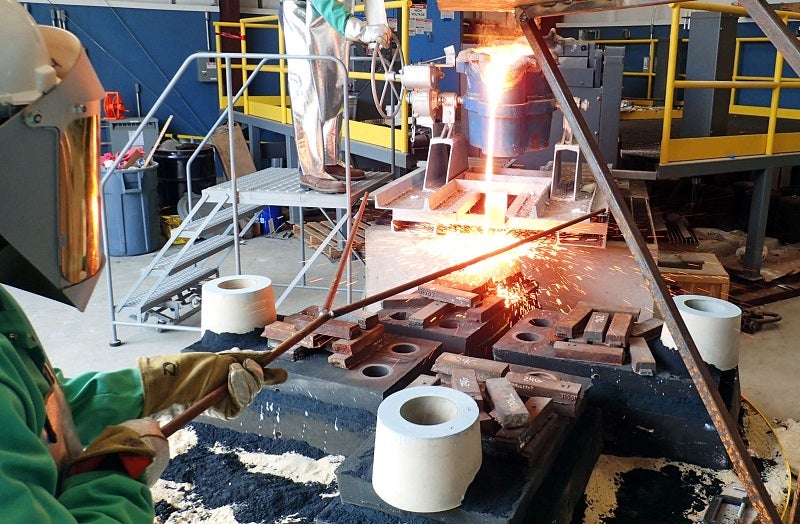
GIW Industries is an industry-leading manufacturer of pumps and high-performance solutions.
GIW develops severe abrasive handling slurry pumps and wear technology. These slurry pumps are used in a wide range of processes, including ore transport, mill discharge, cyclone feed, tailings and mineral processing.
The slurry pumps feature a rugged design and are available in the proprietary GIW Gasite® white iron alloy, which offers superior physical properties and wear resistance.
GIW’s senior material engineer Paul Taylor talks about Gasite:
What are the key features of Gasite?
Gasite is not a single material, but a family of proprietary white iron alloys developed by GIW for use in our OEM centrifugal slurry pumps, industrial castings, and spare parts.
The dozen or so alloys in the Gasite family have been individually tuned to provide optimum service life in a variety of service conditions. The key properties for these applications include abrasion/erosion resistance, tensile strength, impact resistance, corrosion resistance, manufacturability, and cost-effectiveness.
In the world of materials improvement in any one property is almost always associated with reduction in one or more other properties, so the key is focusing on optimisation with a proper balance for a specific range of applications.
Tell us about the development of Gasite and how it is incorporated into mill discharge pumps?
According to the GIW history book, the trademarked ‘Gasite’ designation was coined by long-time President and partial Owner, Tom Hagler. The name is believed to be a combination of ‘Ga’ for ‘Georgia’ and ‘site’, which ‘sounded like hard metal’ to Mr Hagler.
It is the author’s opinion that this association is related to the technical names for the various carbon-iron phases including austenite, ferrite, cementite, and especially martensite, which is one of the hardest phases. However, this is conjecture, what is known is that the trademark originated in the late 1940s and was applied to all of GIW Minerals proprietary alloys until the development of the Endurasite family in the mid-late 2000s.
The Gasite alloy family still represents the majority of the alloys used in the production of slurry pump casings, impellers, and wear liners, and development continues! A new R&D foundry building was commissioned in early 2018 featuring a new 175kW Inductotherm coreless induction melting system. The new system includes three separate melting furnaces with 500lb, 150lb, and 50lb capacity respectively. The higher capacity, and greater speed and efficiency of the new system facilitate the development of new alloys and improvement of existing alloys in two important ways.
Firstly, it makes it possible for research alloys to be poured with a similar modulus to the production castings, which greatly shortens the ramp-up from research to production. For those not familiar with the term ‘casting modulus’, it can be imagined as the diameter of the largest ball/sphere that could be cut from a casting. Secondly, it enables multiple experimental treatments to be performed on a batch of material with identical composition, or identical pour temperature, which is not practically possible with a smaller melt capacity.
What differentiates Gasite from similar materials?
The Gasite family of proprietary alloys have been developed and tuned specifically for the manufacture of slurry pumps. As mentioned previously, in the world of materials development of an alloy is always a question of balancing the various required properties and the demands of the service or application in order to achieve the best possible outcome.
Thus, while it is true that GIW’s Gasite alloys are among the best high alloy white iron alloys in the world, GIW’s extensive experience in the field of hydraulic transport is also a critical factor in ensuring proper material selection, the process of matching the service conditions with alloy properties.
In addition to increased uptime and reduced maintenance, what other benefits does it have?
With proper material selection, the Gasite family of alloys can provide protection from sudden or unplanned outages due to tramp material, improved throughput, predictable lifecycles, and transport of chemically aggressive slurries. One often-overlooked benefit of Gasite alloys is their manufacturability.
High alloy white irons are brittle by nature, intolerant of defects, and more difficult to produce than competing materials such as steel alloys. The properties of the Gasite family of alloys and GIW’s experience in producing them have enabled the production of the largest slurry pumps in the world, including pour weights up to 52,000lb and impeller diameters up to 115in.
You mentioned it being used at iron ore pumps. What other environments or applications has it been applied?
The Gasite family of alloys is used in all GIW Minerals slurry pumps and industrial castings. This means that these alloys have been applied in mining and milling oil sands, phosphate matrix, copper ore, gold, salt, kaolin clay, sand, and a variety of other materials. They have also been applied in dredging fresh and intercoastal waterways, settling ponds, and undersea mining.
Chemically resistant Gasite alloys are often applied in mineral processing, fertiliser production, chemical production, and flue-gas desulfurization (scrubbing). Finally, industrial castings are used to pulverise coal, limestone, and a variety of other materials for processes such as fluidised bed combustion and cement production.
Are there any additional markets that could benefit from using Gasite?
The Gasite family of alloys has been tuned to the production of slurry pumps and industrial castings, but any service that requires abrasion resistance and service life beyond that provided by steel alloys could potentially benefit from one or more of the Gasite alloys.


